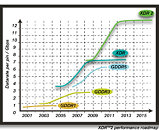Apr 10th, 2025 04:23 EDT
change timezone
Latest GPU Drivers
New Forum Posts
- [Update] FanControl (and other different monitoring software) blocked by Defender due to Winring0 vulnerability (2)
- Do you use Linux? (572)
- Help with updating firmware on a AOC Agon Pro OLED monitor, says I need Install Tool (3)
- HP EliteDesk 800 G2 SFF CPU support (2)
- Anyone know where to get driver updates / backdates for TUF A15? (4)
- EK Quantum Velocity intel to amd conversion (13)
- How is the Gainward Phoenix Model in terms of quality? (0)
- ## [Golden Sample] RTX 5080 – 3300 MHz @ 1.020 V (Stock Curve) – Ultra-Stable & Efficient (44)
- hp envy 15 rtx 2060 max-q stock vbios (1)
- (Some of) What I'd like to See From a Final Fantasy IX Remake (10)
Popular Reviews
- The Last Of Us Part 2 Performance Benchmark Review - 30 GPUs Compared
- ASRock Z890 Taichi OCF Review
- MCHOSE L7 Pro Review
- Sapphire Radeon RX 9070 XT Pulse Review
- PowerColor Radeon RX 9070 Hellhound Review
- Upcoming Hardware Launches 2025 (Updated Apr 2025)
- Sapphire Radeon RX 9070 XT Nitro+ Review - Beating NVIDIA
- Acer Predator GM9000 2 TB Review
- ASUS GeForce RTX 5080 Astral OC Review
- UPERFECT UStation Delta Max Review - Two Screens In One
Controversial News Posts
- NVIDIA GeForce RTX 5060 Ti 16 GB SKU Likely Launching at $499, According to Supply Chain Leak (174)
- MSI Doesn't Plan Radeon RX 9000 Series GPUs, Skips AMD RDNA 4 Generation Entirely (146)
- Microsoft Introduces Copilot for Gaming (124)
- AMD Radeon RX 9070 XT Reportedly Outperforms RTX 5080 Through Undervolting (119)
- NVIDIA Reportedly Prepares GeForce RTX 5060 and RTX 5060 Ti Unveil Tomorrow (115)
- Over 200,000 Sold Radeon RX 9070 and RX 9070 XT GPUs? AMD Says No Number was Given (100)
- Nintendo Switch 2 Launches June 5 at $449.99 with New Hardware and Games (99)
- Nintendo Confirms That Switch 2 Joy-Cons Will Not Utilize Hall Effect Stick Technology (99)
News Posts matching #XDR2
Return to Keyword Browsing
NVIDIA Releases GeForce 441.20 WHQL Drivers
NVIDIA today posted GeForce 441.20 WHQL software. The drivers come game-ready for "Star Wars Jedi: The Fallen Order," and "Stormland." This includes SLI support for the latest Star Wars game. NVIDIA also introduced support for CUDA 10.2 compute API. The list of G-Sync compatible monitors has been expanded with three more displays. Among the issues addressed with this release are geometry corruption on GTX 900-series "Maxwell" GPUs with "Red Dead Redemption" in Vulkan; G-Sync getting disengaged when V-Sync is disabled in "Red Dead Redemption." Vulkan-related errors with "The Surge" have also been fixed. There's also a surprising bug-fix, "Quake 3 Arena" appearing washed-out when color-depth is set to 16-bit. Performance drops with "CS: GO" have also been addressed. Grab the driver from the link below.DOWNLOAD: NVIDIA GeForce 441.20 WHQL Drivers

Noises About Radeon HD 7900 Series with XDR2 Memory Grow
As early as in September, we heard reports of AMD toying with Rambus XDR2 memory on its next generation of high-performance GPUs. Apart from our own community's response, that news met with a wall of skepticism as it was deficient in plausibility. New reports from Chinese websites have raised the topic again with fresh rumors that AMD will attempt to implement XDR2 on some of its next-generation ultra-high end products after all. XDR2, according to Rambus, can transport twice the amount of data per clock as GDDR5.
Apparently AMD and Rambus have had much more cordial relations with each other, than other companies the latter engaged in patent disputes with. In 2006, AMD settled outstanding disputes with Rambus by willing to pay licensing costs for certain technologies claimed by Rambus, turning a leaf in the relations between the two. What Chinese sources are suggesting now, is that AMD will design its high-end GPU (codename: "Tahiti") in a way that will let it support both GDDR5 and XDR2. Certain higher-end SKUs based on Tahiti will use XDR2, while the slightly more cost-effective SKUs will use GDDR5.
Apparently AMD and Rambus have had much more cordial relations with each other, than other companies the latter engaged in patent disputes with. In 2006, AMD settled outstanding disputes with Rambus by willing to pay licensing costs for certain technologies claimed by Rambus, turning a leaf in the relations between the two. What Chinese sources are suggesting now, is that AMD will design its high-end GPU (codename: "Tahiti") in a way that will let it support both GDDR5 and XDR2. Certain higher-end SKUs based on Tahiti will use XDR2, while the slightly more cost-effective SKUs will use GDDR5.

Radeon HD 7900 Series to Use XDR2 Memory?
AMD's next-generation enthusiast graphics processor (GPU) is shaping up to be something more unique than expected. The GPU codenamed "Tahiti" is going to be bleeding-edge in terms of its feature-set. To begin with, there's talk that it will make use of PCI-Express Generation 3 (Gen 3) system bus, which will give it a mammoth 32 GB/s of system interface bandwidth. Next, Tahiti will use a number-crunching architecture that's a generation ahead of even the VLIW4 it released with Cayman. VLIW4 will make up for most of the HD 7000 series, but not the top-end Tahiti GPU, it will use what AMD is referring to as "CoreNext Architecture", which is expected to boost performance per square millimeter die area beyond even what VLIW4 manages.
The most recent piece of information is bound to shock and awe. Tahiti, it appears, will use the XDR2 memory interface. XDR2 is an ultra-high bandwidth and power-efficient memory bus that's competitive with GDDR5, maintained by Rambus, which is claimed by it to be a generation ahead of GDDR5. It's not like XDR2 will be exotic to AIBs, the XDR architecture is used in game consoles where the high-bandwidth offsets low memory capacity by allowing quick streaming of texture data. Rambus licenses XDR memory chip manufacture to notable high-volume vendors. Nordic Hardware compiled data from various unreliable sources to sketch out what Radeon HD 7900 series could look like.
The most recent piece of information is bound to shock and awe. Tahiti, it appears, will use the XDR2 memory interface. XDR2 is an ultra-high bandwidth and power-efficient memory bus that's competitive with GDDR5, maintained by Rambus, which is claimed by it to be a generation ahead of GDDR5. It's not like XDR2 will be exotic to AIBs, the XDR architecture is used in game consoles where the high-bandwidth offsets low memory capacity by allowing quick streaming of texture data. Rambus licenses XDR memory chip manufacture to notable high-volume vendors. Nordic Hardware compiled data from various unreliable sources to sketch out what Radeon HD 7900 series could look like.
Rambus Demonstrates Superior Power Efficiency of World's Fastest Memory
Rambus Inc., one of the world's premier technology licensing companies specializing in high-speed memory architectures, today showcased a silicon demonstration of a complete XDR memory system running at data rates up to 7.2Gbps with superior power efficiency. This silicon demonstration consists of Elpida's recently-announced 1Gb XDR DRAM device and an XIO memory controller transmitting realistic data patterns. The XIO memory controller is up to 3.5 times more power efficient than a GDDR5 controller, and the total memory system can provide up to two times more bandwidth than GDDR5 at equivalent power. In addition, the XIO memory controller demonstrated bi-modal operation with support for both XDR DRAM as well as next-generation XDR2 DRAM.
"Future graphics and multi-core processors require significantly higher memory performance under extremely challenging power and thermal constraints," said Martin Scott, senior vice president of Research and Technology Development at Rambus. "This technology demonstration highlights the outstanding power efficiency of the XDR and XDR2 memory architectures at performance levels from 3.2 to 7.2Gbps with scalability to well over 10Gbps."
"Future graphics and multi-core processors require significantly higher memory performance under extremely challenging power and thermal constraints," said Martin Scott, senior vice president of Research and Technology Development at Rambus. "This technology demonstration highlights the outstanding power efficiency of the XDR and XDR2 memory architectures at performance levels from 3.2 to 7.2Gbps with scalability to well over 10Gbps."
Apr 10th, 2025 04:23 EDT
change timezone
Latest GPU Drivers
New Forum Posts
- [Update] FanControl (and other different monitoring software) blocked by Defender due to Winring0 vulnerability (2)
- Do you use Linux? (572)
- Help with updating firmware on a AOC Agon Pro OLED monitor, says I need Install Tool (3)
- HP EliteDesk 800 G2 SFF CPU support (2)
- Anyone know where to get driver updates / backdates for TUF A15? (4)
- EK Quantum Velocity intel to amd conversion (13)
- How is the Gainward Phoenix Model in terms of quality? (0)
- ## [Golden Sample] RTX 5080 – 3300 MHz @ 1.020 V (Stock Curve) – Ultra-Stable & Efficient (44)
- hp envy 15 rtx 2060 max-q stock vbios (1)
- (Some of) What I'd like to See From a Final Fantasy IX Remake (10)
Popular Reviews
- The Last Of Us Part 2 Performance Benchmark Review - 30 GPUs Compared
- ASRock Z890 Taichi OCF Review
- MCHOSE L7 Pro Review
- Sapphire Radeon RX 9070 XT Pulse Review
- PowerColor Radeon RX 9070 Hellhound Review
- Upcoming Hardware Launches 2025 (Updated Apr 2025)
- Sapphire Radeon RX 9070 XT Nitro+ Review - Beating NVIDIA
- Acer Predator GM9000 2 TB Review
- ASUS GeForce RTX 5080 Astral OC Review
- UPERFECT UStation Delta Max Review - Two Screens In One
Controversial News Posts
- NVIDIA GeForce RTX 5060 Ti 16 GB SKU Likely Launching at $499, According to Supply Chain Leak (174)
- MSI Doesn't Plan Radeon RX 9000 Series GPUs, Skips AMD RDNA 4 Generation Entirely (146)
- Microsoft Introduces Copilot for Gaming (124)
- AMD Radeon RX 9070 XT Reportedly Outperforms RTX 5080 Through Undervolting (119)
- NVIDIA Reportedly Prepares GeForce RTX 5060 and RTX 5060 Ti Unveil Tomorrow (115)
- Over 200,000 Sold Radeon RX 9070 and RX 9070 XT GPUs? AMD Says No Number was Given (100)
- Nintendo Switch 2 Launches June 5 at $449.99 with New Hardware and Games (99)
- Nintendo Confirms That Switch 2 Joy-Cons Will Not Utilize Hall Effect Stick Technology (99)





